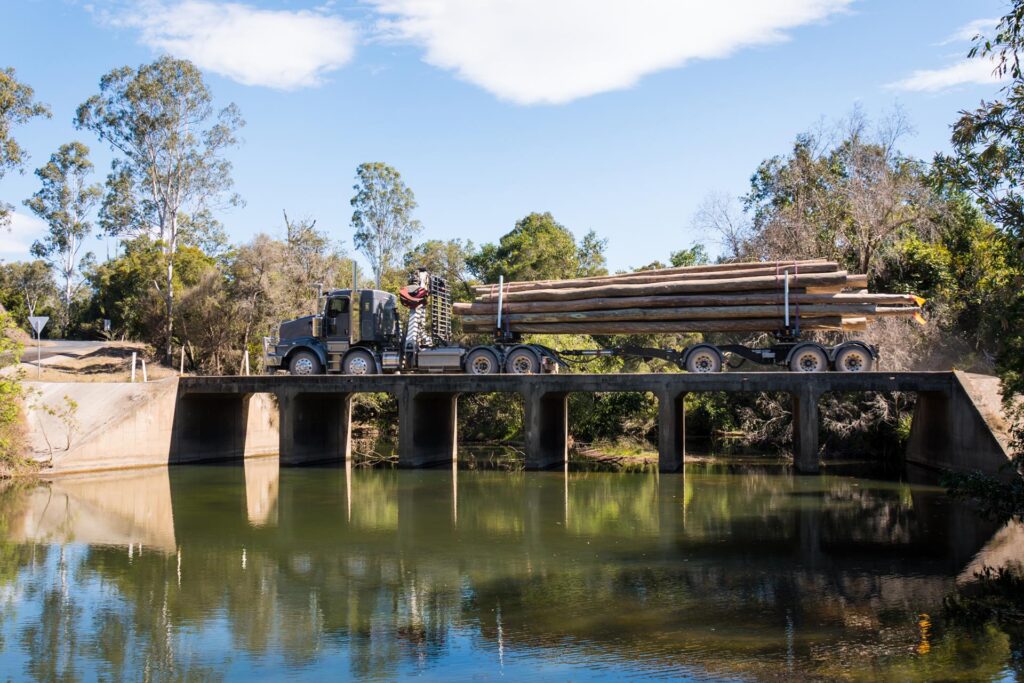New Elphinstone steerable Dog-Logger improves road safety and lifts productivity standards for Queensland-based Suncoast Harvesting.
“If you’re interested in a good story on something new, then give Greg Watson at Suncoast Harvesting a call up in Gympie,” Graeme Elphinstone suggested. “We’ve recently commissioned a new trailer fitted with our EasySteer suspension and a full loadcell set for high accuracy onboard weighing. You’ll be impressed when you see it,” he added.

Later that morning, I gave Greg a call. “Yeah, come up and take as many photos as you want,” Greg said over the phone. “It’s only early days, but so far, the trailer is performing better than we expected.”
Early the following week, I met up with Greg at his depot on the north side of Gympie. Greg’s operation, Suncoast Harvesting, predominantly supplies high-value native plantation hardwoods for use as power poles and furniture timber.
“When I was tendering for this contract, I was searching for a trailer that could deliver higher payloads with improved safety options that were also easier on tyres, maintenance and the roads,” Greg explained. “During my research, I noticed some unique trailers on the Elphinstone website, especially similar trailer concepts to this Dog-Logger. I approached Graeme about building a unit specifically to suit our needs. Thankfully, Graeme agreed,” he added.
“One of the unique requirements in our contract is there are times when our customers require 19-meter-long power poles,” Greg said, “It’s not every day, but when they require those extra-long poles, we must have equipment that can transport the product from the plantation to the customer’s desired location.”

Elphinstone EasySteer DogLogger carries 19-meter long logs.
“Looking ahead, we realised significant changes are coming into our industry, especially with the harvesting of native timber regulations and codes of practice,” Greg explained. “One particular item is with the area we have available to load trucks is getting tighter as the push to reduce our footprint in the forest becomes more critical. Consequently, this doesn’t leave a lot of room to turn a semi-trailer around at the landing, so it was essential that the trailer fold up to allow us access to more forest areas.
The folding Dog-Logger is another groundbreaking trailer using Elphinstone Engineering’s EasySteer suspension system to improve vehicle handling safety and productivity. The trailer includes a long list of innovative features, including telescopic pole sections that allow the operator to close or extend the distance between the bolsters to suit best the length of logs being carried.
But it also draws on traditional features such as the self-tracking steering. Self-tracking trailers are not a new concept. Loggers have used them for decades. The Dog-Logger uses what’s commonly referred to as the stinger-steer principle, which gives the trailer its self-tracking action.

Stinger-Steer: How it works
The trailer is coupled to the rear of the truck’s chassis, and the stinger-steer makes use of the rear overhang of the truck to swing the ‘reach’ as it’s called of the trailer around the corner. When loaded, the logs actually pull the trailer, and the telescopic pole extends (gets longer) as the truck corners.
The effect of this self-steering principle is that the trailer wheels follow reasonably closely to where the truck wheels go. How closely the trailer wheels follow the truck wheels depends on the ratio of the length of the ‘stinger’ as measured from the pivot point on the truck, typically the centre of the drive wheels, to the hitch as compared to the distance from the centre of the trailer axle group to the hitch. If those distances are exactly equal, the trailer’s wheels will follow precisely in the truck’s wheel tracks. But practically speaking, most configurations have a shorter stinger length, like Greg’s Dog-Logger. This means that the trailer wheels closely follow the path of the truck’s wheels, but not exactly. However, the Dog-Logger’s swept path is radically less than a classic tri-axle trailer. This is a significant benefit not only when on the highway, where it is possible to keep the truck and trailer in its own lane even on a windy road, but is also invaluable on twisting, narrow logging tracks out in the forest.
This simple, reliable technology allows for extra-long loads to proceed down twisting roads. The logs in these photos are close to 18.5 meters long, well outside the limit for a conventional semi-trailer configuration. Yet it’s not until you compare the Dog-Logger’s self-steering characteristics when extended to carry the 18.5-meter-long poles to the swept path of a traditional extendable trailer that you start to realise the safety benefits for other road users because when the Dog-Logger corners, it stays in its own lane. When a conventional extendable trailer takes a corner, the prime mover must swing wide into the opposite lane to get the trailer around a corner.
EasySteer Suspension: How it works
The EasySteer suspension is the only trailer suspension to offer proper load share and self-steering capability at all vehicle speeds. Because the EasySteer suspension uses a single-point pivot to connect to the trailer, it allows it to oscillate beneath the trailer chassis freely. This means the suspension has greater freedom to follow the road profile without losing suspension travel.
A ballrace turntable on top of the EasySteer suspension enables the suspension to follow the prime mover’s wheel track closely, thanks to the stinger-steer pole coupling mentioned above. For a more detailed description of how the EasySteer suspension operates, read the “Evolution of EasySteer story”.

Loadcells: How it works
First, let’s explain what a loadcell is and how it works. The theory behind a loadcell is it’s a transducer that converts a mechanical force into an electrical signal. It operates on the principle of strain gauge technology, where the deformation of a material results in a change in its electrical resistance. This change in resistance can be measured and translated into an accurate weight or force reading displayed on a reader located in the dash or hand-held device.
A pair of loadcells are mounted under the front bolster, and another pair is mounted under the rear bolsters to allow for accurate on-vehicle weighing. Elphinstone loadcells are precisely accurate and measure in increments for 10kg, 20kg, 50kg or 100kg. Typically, operators set their loadcells to measure in 50kg increments in road transport applications like logging. Conversely, in agricultural applications, farmers would set their loadcells to 10kg for precise measurement of materials such as fertilisers.
When the loadcell is set at 50kg increments, it weighs to an accuracy of less than one per cent of the payload. Interestingly, Elphinstone loadcells do not require full air pressure to operate, meaning there is no need to keep the engine running during the loading process, thereby reducing engine hours and saving valuable fuel. Furthermore, loadcell accuracy is unaffected if a wheel has dropped into a pothole at the loading area, all factors that cause inaccuracy with air-transducer scales.

Inventor Graeme Elphinstone with the EasySteer.
The cost of overloading today carries significant costs, not only in fines from the NHVR but also in loss of earnings and penalties placed on operators by sawmills under their COR requirements.
Conversely, the cost of ‘underloading’ to maintain a safety window is costly for operators, too, in terms of lost earnings. It’s expensive for sawmillers, too, because additional truckloads are required to transport their log quota into the sawmill.
For some transport operations, the ROI (return on investment) on Elphinstone loadcells can be as short as several months, depending on the volume of timber or products being transported and the number of tonnes underloaded each trip.
“Those loadcells are very, very accurate, Greg explained. “I can get the payload within 100 kilograms of our GCM every load. I don’t have to worry about airbags and tyres sitting in holes. The loadcells are consistent all the way through, and we’ve got very undulating dump sites and not the best of roads, so that’s testament to how good they are in my book,” he added.
“It’s just absolutely unbelievable where this Dog-Logger will go, even stretched out to longer lengths,” Greg enthused. You don’t require any extra bit of road to turn out into areas because we haven’t got the room in many of our tracks anyway. They are just very narrow, very tight and very winding. Even with minimal room, this Dog-Logger follows you all day. You’re not cutting into corners or swinging very wide like you would with a conventional tri-axle skel-trailer.”

Greg Watson keep watches the Easyweigh remote reader as the poles are loaded onto the DogLogger.
“This thing doesn’t cut corners at all, particularly as the trailer is coupled to the back of the chassis on the prime mover. As the back of the prime mover moves out, the trailer goes with it and follows it around in its own arc basically,” Greg explained. “When you first look at the Dog-Logger, it looks like quite a complex trailer, but it is also quite simple in its own right. It’s just a matter of getting your head around it. So far, I haven’t had any issues with it.”
“But one thing I’d like to finish with,” Greg requested. “This is to make a special mention of the quality of the build of the trailer and everything around it; is just it’s Second-To-None. It is really fantastic to see someone take so much pride in their work and a big thanks to Graeme and all his team. I’m absolutely ecstatic with the job that they’ve done,”
“But importantly, we now have a low maintenance trailer that meets all the compliance requirements, is economical to operate, delivers high productivity, and offers greater safety to other road users,” Greg concluded.
 Releated Reading
Releated Reading
Elphinstone Introduces Self-Loading Log Trailers
Elphinstone on vehicle weighing system saves.





